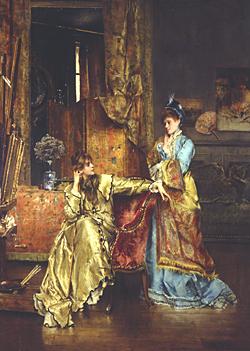
october 18, 2000–april 8, 2001
the visit
The Visit, also known as The Morning Call, shows a young woman artist in a silvery peignoir. Behind her is a table with a still life set against a Chinese screen, which in turn marks off an alcove. Within those gloomy depths the tall windows are shuttered, allowing in only a strip of light, painted in a single stroke of impasted white paint that asserts the surface of the painting, while reflections in a round mirror catch the colors of the foreground in a relay of surface and depth. The painting is perfectly plotted in its formal relations to create a satisfying visual experience, yet there is a hidden irony: the painting presents a woman painter and her pictures, but we see this painter as a subject in Stevens's picture. We see a painted room whose space is punctuated and punctured by mirrorsflat surfaces that reflect imagined depthand paintings that create imagined depth, opening up the flat walls. Color links both back to the central Figures that are the dramatic point of intense and unusual color harmonies. The painting demonstrates Stevens's idea of what a painting is: a fiction of surface and space evoking an open meaning through its internal relations and carefully observed and choreographed gestures. This idea of art is represented by women as both artist and viewer, linking the feminine with the creation and discerning appreciation of art, as well as with an intimate relation through costumeat this moment in the modern history of dress we name "fashion"to the color harmonies beloved of the modern painter. Stevens was above all interested in painting figures in interiors. He used a paradox to evoke the intimation of an inner being in his subjects by his scrupulous attention to surface and dress. His figures are not characters in a story, yet this painting is like a novel. Stevens has made up scenes and characters for his models, attending to details of dress, furniture, and situations his viewers would understand as signs. Balzac wrote a series of novels collectively called La Comdiehumaine, and he made every detailof the room in which a person lived, the clothes they wore, the ways they satwork to create a picture of a character type. Stevens was called the Balzac of painting, his paintings a Comdie fminine.

